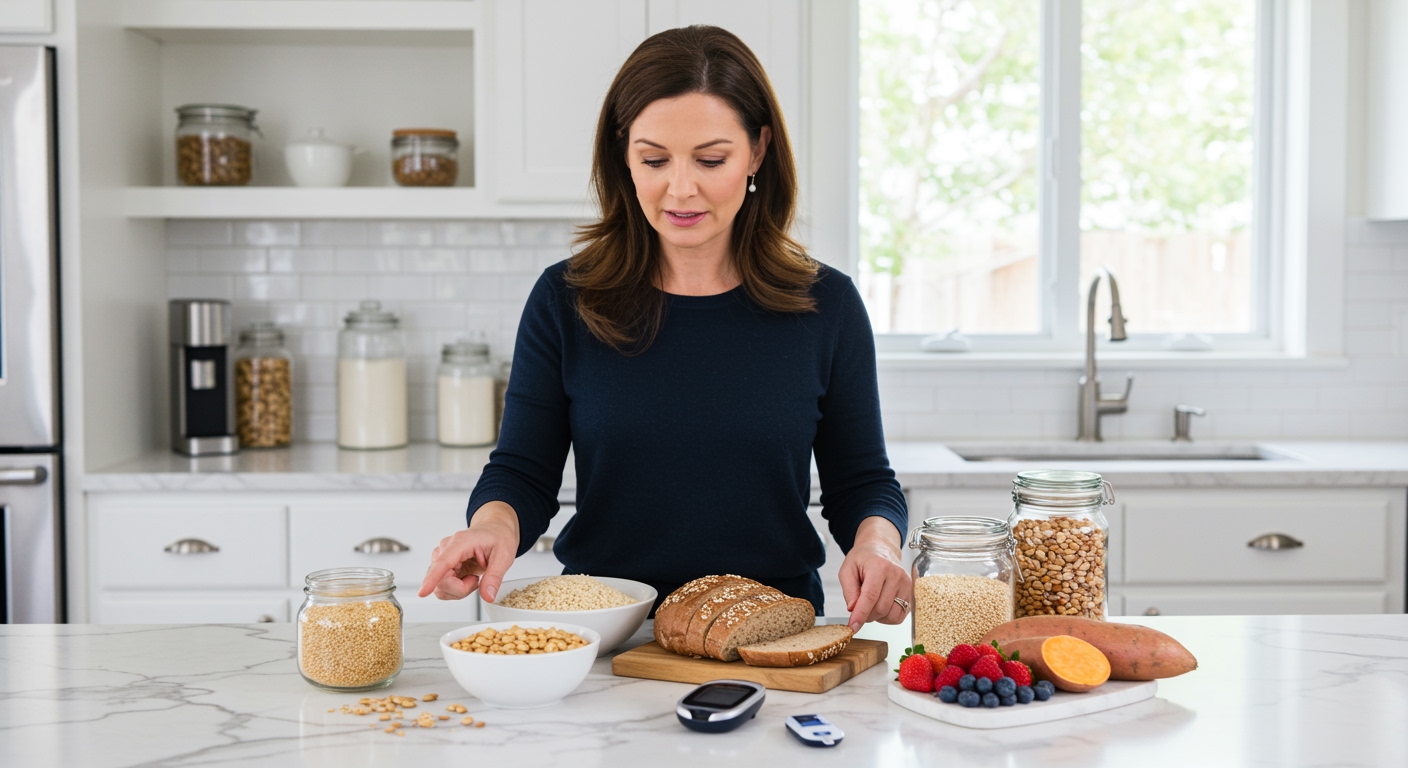✪ Key Takeaway: Skim milk can raise blood sugar faster than whole milk due to quicker absorption and higher glycemic response.
Introduction
You walk down the dairy aisle and reach for skim milk because someone told you it was healthier for diabetes.
Many people with diabetes choose skim milk thinking the lower fat content makes it automatically better for blood sugar control.
Hi, I am Abdur, your nutrition coach and today I am going to explain whether skim milk is actually good for diabetes and what the science really says about milk choices for blood sugar management.
How Does Skim Milk Affect Blood Sugar Levels?
Skim milk contains about 12 grams of lactose per cup, which is a natural sugar that converts to glucose in your bloodstream.
When you remove the fat from milk, you create a product that your body absorbs more quickly than whole milk.
The glycemic index of skim milk ranges from 32 to 37, which is considered moderate but still significant for people managing diabetes.
Research shows that skim milk can cause a blood sugar spike within 30 minutes of consumption because the lactose enters your bloodstream without the buffering effect of fat.
Your pancreas responds by releasing insulin to manage this glucose surge, which can be problematic if you already have insulin resistance.
✪ Fact: Skim milk actually has a higher glycemic response than whole milk due to faster absorption rates.
Why Does Fat Content Matter For Diabetes?
Fat acts as a natural brake system for sugar absorption in your digestive tract.
When you drink whole milk, the fat content slows down the gastric emptying process, which means lactose enters your bloodstream more gradually.
This slower absorption helps prevent the sharp blood sugar peaks that can be dangerous for people with diabetes.
Studies indicate that the fat in whole milk also triggers the release of hormones like GLP-1, which helps regulate insulin sensitivity and glucose metabolism.
The protein in milk works better with fat present, creating a more balanced nutritional profile that supports stable blood sugar levels.
Without fat, skim milk essentially becomes a liquid carbohydrate that your body processes similar to other sugary drinks.
✪ Pro Tip: Choose whole milk or 2% milk to slow sugar absorption and maintain steadier blood glucose levels.
What About The Calcium And Protein Benefits?
Skim milk does provide excellent protein content with about 8 grams per cup, which can help with muscle maintenance and satiety.
The calcium content remains high in skim milk, offering about 300 milligrams per cup, which supports bone health and may help with insulin function.
Research from the University at Buffalo suggests that calcium plays a role in insulin secretion and glucose metabolism, potentially benefiting people with diabetes.
However, these benefits come with the trade-off of faster sugar absorption that can destabilize blood glucose levels.
The protein in skim milk can help slow some sugar absorption, but it is not as effective as the fat content found in whole milk.
You can get similar nutritional benefits from other dairy products like Greek yogurt or cheese that have better blood sugar profiles.
✪ Note: Protein and calcium benefits do not outweigh the blood sugar risks for most people with diabetes.
When Might Skim Milk Be Acceptable For Diabetes?
Some people with well-controlled diabetes might tolerate small amounts of skim milk without significant blood sugar spikes.
If you are using skim milk in protein smoothies with fiber-rich ingredients like berries or spinach, the additional nutrients can help slow absorption.
People who exercise regularly might handle skim milk better because their muscles can utilize glucose more efficiently during and after workouts.
The timing matters too – consuming skim milk with a balanced meal that includes protein, fat, and fiber can minimize blood sugar impact.
However, drinking skim milk alone or on an empty stomach is generally not recommended for people managing diabetes.
Your individual response may vary, so blood glucose monitoring after consuming skim milk will give you the most accurate information about how your body reacts.
✪ Pro Tip: Test your blood sugar 1-2 hours after drinking skim milk to understand your personal response pattern.
What Are Better Milk Alternatives For Diabetes?
Unsweetened almond milk contains only 1-2 grams of carbohydrates per cup compared to 12 grams in skim milk.
Coconut milk provides healthy fats that can actually help improve insulin sensitivity when consumed in moderation.
Hemp milk offers a good balance of protein and omega-3 fatty acids with minimal impact on blood sugar levels.
If you prefer dairy, whole milk in smaller portions often creates less blood sugar volatility than larger amounts of skim milk.
Greek yogurt diluted with water can provide similar protein benefits with better blood sugar control due to its probiotic content.
The key is choosing options that provide nutrition without causing rapid glucose elevation that stresses your insulin system.
✪ Fact: Unsweetened plant-based milks typically cause 75% less blood sugar impact than skim milk.
The Bottom Line
Skim milk is not the best choice for most people with diabetes because it can cause faster and higher blood sugar spikes than whole milk or plant-based alternatives.
Smart nutrition means choosing foods that work with your body, not against it, especially when managing a condition like diabetes.
I would love to hear about your experience with different types of milk and how they affect your blood sugar – please share your thoughts or questions in the comments below.
References
At NutritionCrown, we use quality and credible sources to ensure our content is accurate and trustworthy. Below are the sources referenced in creating this article:
- University at Buffalo: Calcium and Insulin Research
- January AI: Glycemic Index of Skim Milk
- Medical News Today: Milk and Diabetes Information
- PMC: Dairy Products and Diabetes Study





